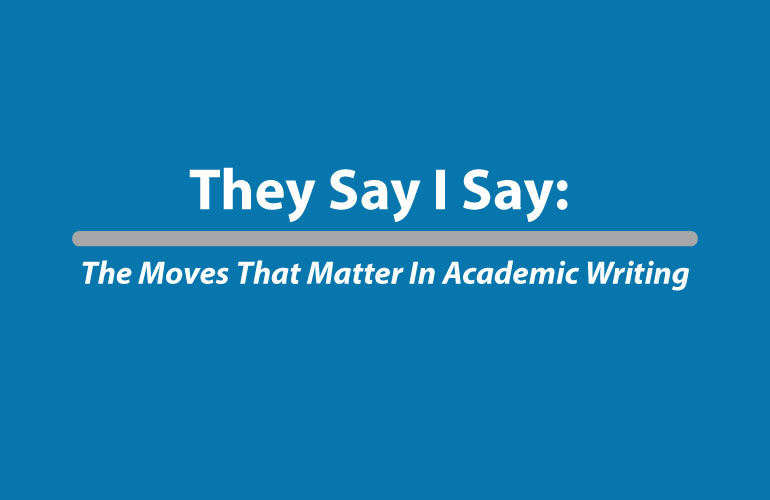Gerald Graff and Cathy Birkenstein wrote the book They Say I Say. In this review, I shall give a brief overview of the content of the book followed by my personal opinion of its effectiveness as a guide.
Graff and Birkenstein have created this book and talk about a few key elements to become a more effective writer. Instead of sounding like sound bites on a piece of paper, their strategy is to offer templates and tools that foster greater depth.
As of 2022, there have been 4 editions of the book. The book’s fourth edition, like the previous editions, is structured into four primary parts, but it now includes online approaches to make it more appropriate for the digital age.
Exactly what “They Say” Means
“They Say,” is the title of the first section. It’s important when writing to take into consideration what other people have said and to learn from them. After you have stated “they say,” feel free to reply with your own thoughts on the issue before moving forward. Summarizing is also a skill that needs to be mastered. A well-written summary presents your point of view while highlighting how it relates to your paper; complementing this skillful ability is quoting. Which must not exceed the length necessary for understanding purposes without sacrificing accuracy or authenticity.
Exactly what it means to say “I say”
Second, you say what you think of what the person has said. When arguing with someone else or defending a position in academic circles, the use of “I” statements is sometimes necessary, even if it’s not always acceptable.
“I Say” is often used as an affirmative, as a negative, or as a combination of both. In disagreeing, you must offer persuasive reasons for the particular view that is not being argued against; if agreeing with an argument, follow it up by providing supporting information about why this argument makes sense based on what was discussed beforehand (or even during). When there is uncertainty over which side to choose, one could combine both sides.
Throughout Part 2, writers will learn how to anticipate objections to their work. Most writers dislike having their work critiqued, yet it can actually be beneficial to them. Using feedback from others as they read your work will improve your writing skills and give your work more credibility. This will also encourage others to participate in the discourse or debate. Getting a naysayer in your work will help you consider what others might say in response to your claims.
What’s meant by “Tying It All Together”
The third part is titled, “Tying it All Together,” it teaches how to make your writing as easy-to-read and enjoyable for readers.
By employing the techniques of pointing words in a manner that gestures back in time to what has already been said, repetition (which ensures points are not lost), and focusing on certain topics or topics paragraph by paragraph, an engaging argument can be produced.
While writing, you must consider the audience and purpose of your paper. For a piece of academic work to have an impact on those who read it, there needs to be an understanding between writer/reader relationship in terms of both what he or she means by saying something specific about the topic while also indicating how this statement may not apply entirely. Graff and Birkenstein coined the term “metacommentary” to describe the art of connecting it by showing readers what the thesis suggests and what it doesn’t based on the topic under discussion.
What does “In Specific Academic Contexts” mean?
The authors cover how to be more effective writers in certain academic circumstances in the fourth section of this book, titled “In Specific Academic Contexts”. Different forms need to be filled out in each topic area. These forms vary depending on what type of communication you will be using when talking in class, when writing online, when reading, and when writing in literature and science courses. All these differ significantly from one another without sacrificing fidelity to others’ ideas. As you sum up what others have already said, make sure to include the unique ideas you want to bring up clearly. Each chapter includes templates that will help you serve the purpose effectively.
Final Thoughts
A book like “They Say, I Say” is refreshing and helpful for anyone who wishes to express one’s personal ideas in the world. By writing an organized text, Graff and Birkenstein have taught readers how to accomplish this goal. It is an easy-to-follow guide that will help you learn how to argue in academic language while not being intimidated by it all.
There are several unique aspects about its writing which make it stand out among other literature on similar topics. One is incorporating cartoons that make it light and fun with all the information overload. It also contains templates that help academic writers formulate ideas and techniques to be better at writing. What I also love about this book is that every chapter ends with some kind of exercise. This means that you don’t just read but get to test what you have learned so far.
Many people have created YouTube videos discussing how excellent this book is for students who are just getting started with the writing process. Likewise, I agree that this book can be an excellent resource to help students make the most of rhetorical moves.




